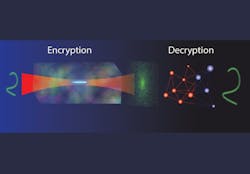A team from the University of Crete and the Institute of Electronic Structure and Lasers of the Foundation for Research and Technology Hellas (ISEL-FORTH), both in Greece, are combining holograms and artificial intelligence (AI) to encode information and data (see video).
“Our optical encryption system (see Fig. 1) uses holography and a dynamically evolving scattering medium to achieve an unprecedented level of security,” says Stelios Tzortzakis, a professor at the University of Crete, and principal researcher and deputy director at ISEL-FORTH.
Traditional optical encryption methods rely on passive scattering media—materials that remain unchanged during the interaction with light. Such approaches obscure information effectively, Tzortzakis explains, but security can become compromised if someone reverse-engineers the scattering process and retrieves the original data.
The Crete/ISEL-FORTH team’s approach introduces what Tzortzakis describes as a fundamental shift: “The scattering medium is actively modified by the light beam itself. As the laser propagates, it dynamically alters the medium in a highly nonlinear manner, which leads to an unpredictable and chaotic transformation of the beam profile.”
This interaction ensures encoded information is scrambled in a way that is physically irretrievable through conventional methods.
System development
The team’s work involves a high-power laser directed through a cuvette (a small tube-like container) filled with ethanol (see Fig. 2). The interaction between the laser and the liquid medium produces thermal turbulence and chaotic behavior within a few millimeters of propagation distance. This creates an encryption system in which the original beam shape is completely concealed, which makes its reconstruction impossible through physical analysis alone.
The team then uses AI—deep neural networks—to enable decryption. Their networks were trained to recognize the intricate light patterns generated by the chaotic scrambling process. This establishes billions of computational connections, similar to synapses in the human brain, and teaches the neural networks to reverse-engineer the encrypted data with the correct decryption parameters.
“It ensures that decryption is not only highly secure but also dependent on a key that is unique to each specific encryption setup,” Tzortzakis says. “As digital threats continue to evolve, there is a pressing need for encryption technologies that surpass traditional computational methods in resilience and reliability.”
Key advantages
The researchers’ optical encryption system addresses critical security challenges that have long hampered optical and digital encryption technologies.
Unlike previous approaches, which use passive scattering media, their system relies on a dynamically evolving medium. Its constant modification via propagating light beams creates an encryption process that is inherently chaotic and impossible to model deterministically, Tzortzakis explains, which “ensures that unauthorized decryption attempts are infeasible, because the exact conditions of the scrambling process are never the same.”
The system also protects against reverse engineering, in which information and data can be analyzed and reversed through computational methods. The interaction between light and the medium in the new system is nonlinear and dynamically evolving and, as a result, any attempt to decipher the encoded information using conventional physics-based models is rendered ineffective.
Their deep neural networks feature a highly intelligent decryption mechanism as well, which is uniquely tied to each encryption configuration. This makes unauthorized access essentially impossible.
“As an optical-based encryption method, our system has the potential to be integrated into next-generation telecommunication technologies, including secure wireless optical communication networks,” Tzortzakis says. The approach’s adaptability means it can be further developed for a wide range of security applications to keep up with the evolving digital landscape.
Steps toward the future
The optical-based system shows promise for more secure communication channels, given its ability to completely scramble and reconstruct information with high fidelity. It could also enhance security for digital finance and currencies, as well as in the healthcare sector for medical data transmission and storage.
The team is working to further enhance the technology by incorporating additional authentication mechanisms, such as multifactor optical encryption, optimizing the neural networks’ performance, and scaling the entire system for real-world use.
Tzortzakis says this work represents a paradigm shift in encryption technology, “moving beyond purely mathematical cryptographic methods toward a physical-layer security solution that is inherently resistant to decryption.”
“As cyber threats continue to evolve, particularly with the rise of quantum computing, traditional encryption methods will face increasing vulnerabilities,” Tzortzakis says. “In the coming years, we envision this technology becoming a cornerstone of next-generation secure communications to safeguard critical information in an era where digital security is more important than ever.”
FURTHER READING
P. Konstantakis, M. Manousidaki, and S. Tzortzakis, Optica, 12, 2, 131–139 (2025); https://doi.org/10.1364/optica.530643.
About the Author
Justine Murphy
Multimedia Director, Digital Infrastructure
Justine Murphy is the multimedia director for Endeavor Business Media's Digital Infrastructure Group. She is a multiple award-winning writer and editor with more 20 years of experience in newspaper publishing as well as public relations, marketing, and communications. For nearly 10 years, she has covered all facets of the optics and photonics industry as an editor, writer, web news anchor, and podcast host for an internationally reaching magazine publishing company. Her work has earned accolades from the New England Press Association as well as the SIIA/Jesse H. Neal Awards. She received a B.A. from the Massachusetts College of Liberal Arts.


